Yes, cats are often afraid of aluminum foil, and it’s not just a random quirk. The crinkling sound and unfamiliar texture can set their instincts on edge, prompting them to instinctively avoid it.
The discomfort caused by the crinkling noise and the strange sensation under their paws or claws is a key factor. Cats thrive on routine and familiarity, so encountering this unexpected material can trigger their natural wariness.
Since most cats dislike the texture, sound, and feel of aluminum foil, it can be an effective tool to discourage them from jumping onto counters or other surfaces. However, cats can eventually become familiar with aluminum foil, but their reactions to it often depend on their personalities and experiences.
Curious about why cats have a thing against aluminum foil? Well, keep reading to find out how to stop those sneaky paws from exploring your countertops!
Why Do Cats Hate Aluminum Foil?
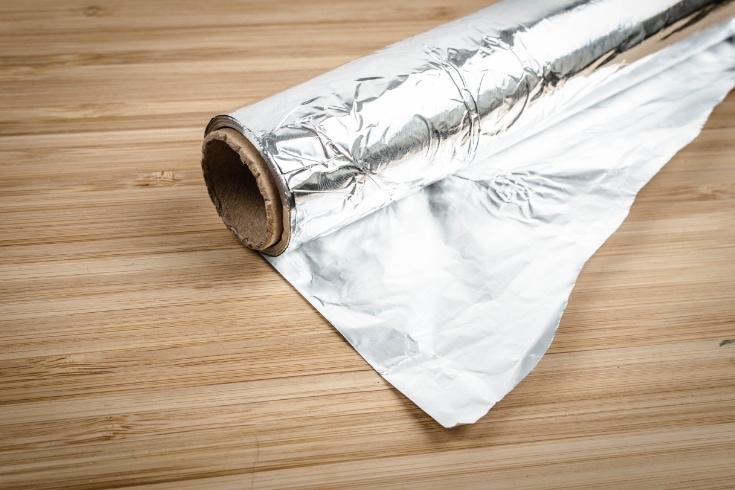
Cats hate aluminum foil primarily because of its uncomfortable texture and startling noise. The crinkling sensation under their paws or claws can be off-putting, making them instinctively avoid it.
Additionally, the unexpected encounter with aluminum foil in their environment and the unfamiliar texture often trigger their aversion. This innate reaction has led many cat owners to use aluminum foil strategically as a deterrent to keep their feline friends away from certain areas or behaviors.
Let’s go over other reasons why cats hate aluminum foil;
Texture and Sound
Imagine walking on bubble wrap without expecting the pop! That’s how cats might feel about foil’s crinkly noise and texture. For cats, this sensation is unexpected and contrasts sharply with the softness of their favorite sleeping spots. It’s no wonder many prefer to keep their paws off!
Reflective Surface
Cats glimpse themselves on this shiny surface and might wonder who’s staring back at them. It can be both fascinating and startling to them. This mirror-like quality of foil can capture their attention and startle them at the same time. For some, it’s a curious game, but for others, it’s a sudden surprise.
Unpredictability
Foil’s always full of surprises, moving and crinkling when they least expect it. The sudden shifts and sounds can catch them off guard, making them hesitant or cautious around it. It’s this element of surprise that often keeps them on their toes!
Scent
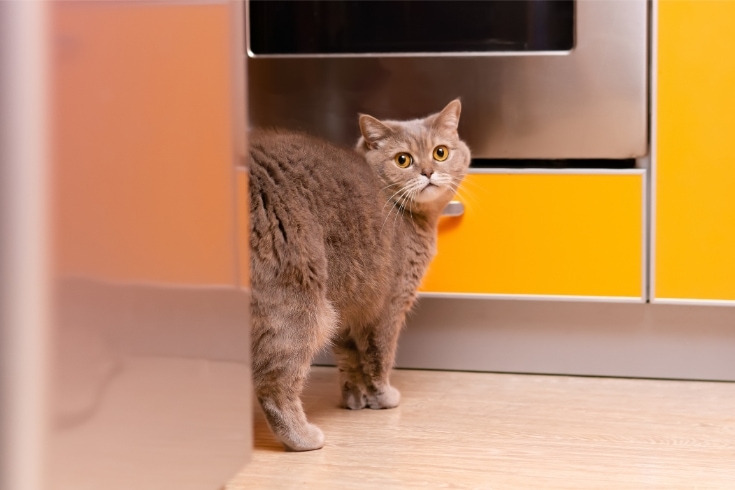
Though not stinky, the metallic scent of foil is certainly not catnip. It’s an unfamiliar smell and our fuzzy buddies often gravitate to what they know. Just as we might be wary of an odd aroma, cats can be put off by scents, too.
Protective Instincts
Cats are naturally cautious and foil is pretty unpredictable, making them tap into their “better safe than sorry” mode. This instinct has been honed over millennia, ensuring their survival in the wild. So, when they encounter something unfamiliar to them like aluminum foil, their first response is to approach or leave it alone altogether.
Negative Associations
A past foil faux pas? Say that ten times fast. If your cat once had an unpleasant encounter with foil, they might remember it and become wary. Just like us, our fuzzy friends can develop aversions based on learned experiences, making them hesitant to approach the shiny stuff again.
Can I Use Aluminum Foil as a Cat Counter Deterrent?
Yes, you can use aluminum foil as a cat deterrent. If you’re wondering about using it to create a kitty no-go zone, you’re in luck. The crinkly noise, shiny surface, and unique feel of the foil are usually enough to make our cats think twice before jumping up. Just lay a sheet on the counter, and voila! It’s a simple and harmless way to set up some kitty boundaries, so give it a whirl and see how your cute furball reacts.
Pros of using aluminum foil
- Deterrent for undesirable behavior–no more kitty paw prints on the counter! Aluminum foil’s got your back, just lay some down and watch as your curious feline friend reconsiders their jumping plans.
- Environmental enrichment–besides the “stay-off” signal, foil can be a great new toy, too! Under supervision, crinkle foil into a ball and it might just be their new favorite toy. Double win!
- Training aid–think of foil as a friendly kitty coach. With a sprinkle of positive reinforcement, vibes, and treats you can help teach your furry pal where they’re welcome and where they’re not.
Cons of using aluminum foil
- Fear and stress–not all cats are a fan of crinkly surprises. While many avoid foil, some might find it too startling. Always keep an eye out and ensure it’s not causing any stress for your feline friend.
- Avoidance of litter boxes–planning to use foil near a litter box? Buyer beware! We don’t want our fuzzy friends associating that with their bathroom spot. It might make them look for alternative places to potty in the house.
- Potential ingestion–remember, curiosity didn’t just kill the cat’s mood; it could be risky! If your furball is the adventurous type, you’ll want to keep a good eye on them to make sure they’re not munching on it.
- Trust issues–building trust with any pet is important! We want them to feel safe and loved around us. If foil becomes a source of fear, they may lose trust in their surroundings or even you.
Remember, every cat is unique and what works wonders for one, might not work for another. Always prioritize the health and well-being of your kitty first.
Do Cats Eventually Become Familiar with Aluminum Foil?
Yes, much like us adjusting to a catchy song playing on repeat, cats can grow accustomed to aluminum foil. Initially, its crinkly charm might throw them off, but over time some cats may just give it a side-eye and carry on with their cat business. Every cat is a unique individual, so while one might find that shiny intruder as scary, another probably sees it as a new toy in their kingdom.
What Are Other Ways to Keep Cats Off Counters?
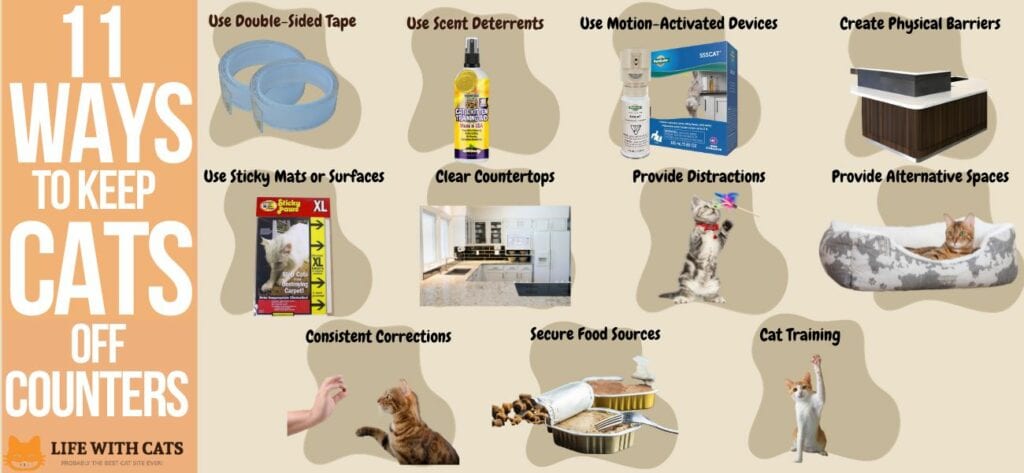
Other ways to keep cats off of counters can include a variety of approaches. Beyond the crinkly world of aluminum foil, there are a bunch of strategies some folks swear by like double-sided tape. Others might use pet-friendly sprays with scents that our kitty friends want to avoid.
There’s also the way of providing alternate high perches or cat trees that are more tempting than a countertop. It’s all about finding what tickles your cat’s whiskers and making home a cheerful space for everyone.
Double-Sided Tape
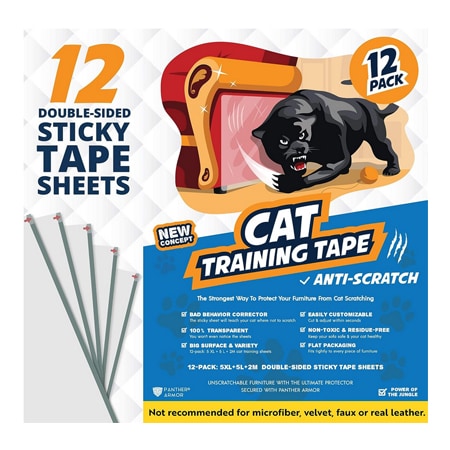
No one likes that sticky feeling! Especially our cool kitty friends. A bit of double-sided tape on counters might make them think twice. It’s a harmless way to guide their behavior and protect your surfaces!
Scent Deterrents
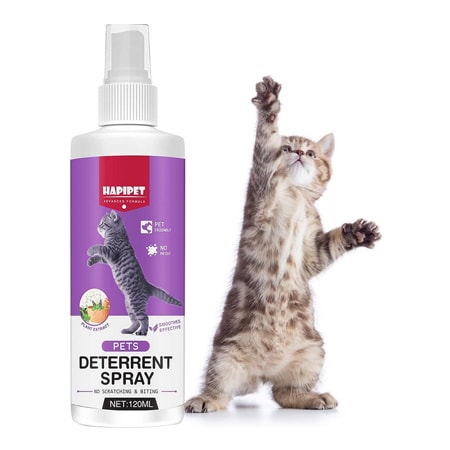
You know that refreshing citrus scent we all adore? Especially clean kitchen hands! Cats don’t like it, and so a little spritz of it on countertops might keep them away.
Motion-Activated Deterrents
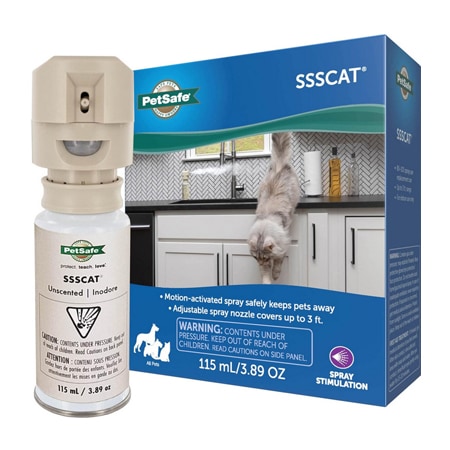
There are lots of clever gadgets out there you can use. Imagine a sudden puff of air as you hop onto the couch, it’s surprising! These deterrents detect your cat’s movement and release harmless deterrents, like air or noise, to discourage them from certain areas. It’s a non-invasive way to set boundaries.
Sticky Mat
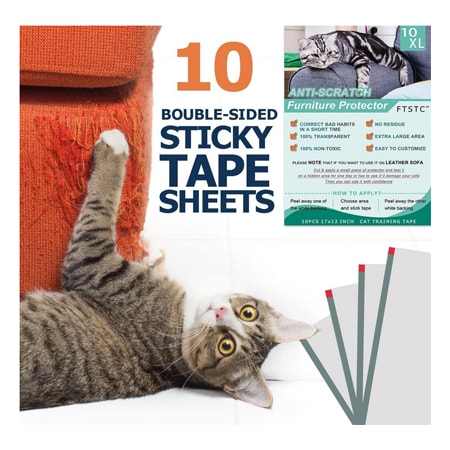
Like the tape, but on a much bigger scale cats still don’t like that tacky feel. A sticky mat can be a game-changer. Place one on your counter or furniture where you don’t want them to be, and your fuzzy buddy might just think twice before leaping.
Clear Countertops
No temptations? No problem! A clear counter is like a boring party for some cats. They’d rather find somewhere else more interesting to hang.
Create Physical Barriers
Some owners will find that putting up physical barriers helps keep curious cats off of where they shouldn’t be. Things that block them from getting on the counter, or from being on the counter such as boxes, furniture, etc., or whatever may work can be useful for your particular home situation.
Provide Distractions
A new food puzzle or toy? Yes, please! Keep those paws and brains busy and entertained so they don’t get into trouble. There are plenty of toys you can find on places like Amazon and Chewy to help entertain your cat and keep them from getting bored.
Alternative Spaces
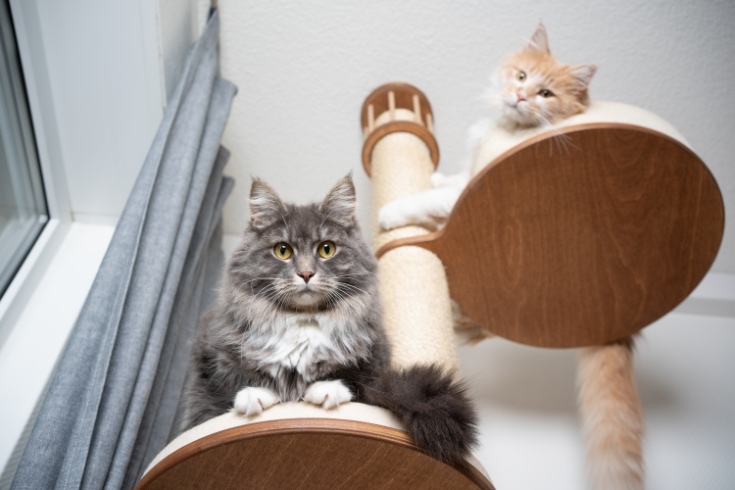
Offering a cat tree or high perch can be like giving your cat their own penthouse. Why would they want to get on the counter if they have an entire tower to themselves?
Consistent Corrections
Gently guiding your kitty off of counters with a loving hand and soft phrase can help some cats catch on. Always remember, soft words work wonders. You want to make sure all interactions with any deterrent are always positive.
Secure Food Sources
Kitties see this as a treasure! Seal up those tempting treats and watch as counters become way less exciting for them to hop onto. If you have a cat that gets into cabinets where you’re trying to hide food and treats, try getting baby locks at any children’s store.
Cat Training
Cats can be trained using positive reinforcement, commands, and clicker training. Positive reinforcement rewards desired behaviors with treats and praise. Simple, consistent commands in a clear voice are essential. Clicker training, a positive reinforcement method, uses a clicker device to mark desired behaviors, followed by a treat to create a positive association and encourage behavior modification.
Positive Reinforcement
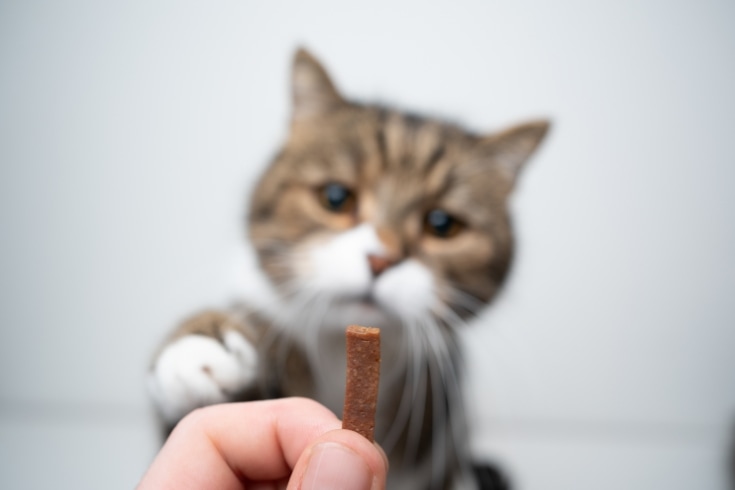
- Catch the good behavior– keep an eye out for when your pet does something good and praiseworthy.
- Immediate reward– as soon as they perform an action you desire, give them a treat or pet them immediately.
- Add a keyword– while praising, say a word like “good” or “yes.” Over time, they’ll associate the word with their good behavior.
- Stay consistent– reward every time your pet does a desired behavior so your pet knows exactly why they’re being praised.
Use Commands
- Choose a command word– these are words like “sit”, “stay”, “come”, and “off”.
- Get their attention– make sure they’re looking at you! It works wonders if you have a treat in your hand.
- Say the command– clearly and firmly (and with love!).
- Wait for the action– the moment they follow through, reward them.
- Repeat– consistency is key. The more they hear the word and get rewarded, the faster they’ll catch on.
Clicker Training
- Introduce the clicker– start by clicking and immediately giving a treat. This helps them think of the clicker as a good thing with positive associations.
- Choose a behavior– decide what you want them to do.
- Wait for the behavior– the moment they do it (or even move in the right direction), click and treat.
- Add a command– once they get the idea the clicker is a good thing, introduce a command word right before the desired behavior.
- Practice makes purrrrrfect– the more sessions you have, the stronger the positive association with command, click, and reward.
FAQ
Do all cats react the same way to aluminum foil?
No, every cat is different and a unique furball of their own personality. While many might be deterred by it and its crinkly noises, some may not bat an eyelid.
Is aluminum foil harmful to cats if they come in contact with it?
No, simply coming in contact with the foil isn’t harmful, however, it can be if it’s ingested. You’ll want to make sure you’re supervising them while they’re playing with foil, as some cats like to chew and chase.
Can I use aluminum foil to train my cat to stay off furniture?
Yes, many cat parents use aluminum foil as a deterrent. Its texture and sound can be off-putting for our kitty companions, making it a good thing for training.
Are there any other materials cats are similarly averse to?
Yes, cats can also be averse to materials like double-sided tape, sticky mats, and certain scents. It’s all about finding what works for you and your kitty while making sure they’re still safe.
How do I introduce aluminum foil as a deterrent without scaring my cat excessively?
To introduce aluminum foil to your cat without startling them, begin by placing it in spots without making a fuss about it. Allow your kitty to become familiar with it and come across it naturally as they explore. Be present during these moments to either reassure them or offer praise, depending on their reaction.
What if my cat shows no reaction to aluminum foil?
No worries! Just like humans have varying tastes and preferences, so do cats! If foil doesn’t work, you can always explore other avenues. You can use other tools such as double-sided tape, sticky mats, or even motion-activated gadgets.
Are there any health concerns if my cat ingests a small piece of aluminum foil?
If a cat ingests tin foil, it can be harmful. There can be potential health risks you’ll have to watch out for, as swallowing foil can cause digestive issues such as blockages. If you think your cat may have snacked on some foil, make sure you reach out to a vet immediately to address any other issues that might come up.
Can I use aluminum foil as a play item for my cat?
Yes, but with supervision. While it can be fun and crinkly, there’s always the risk of them eating some of it. So, always ensure that playtime with foil is under supervision.
Is the aversion to aluminum foil more pronounced in kittens?
No, it varies. While kittens can be more curious and cautious than our adult friends, their reaction to foil isn’t necessarily stronger than an adult cat’s reaction.
What are some signs that my cat is stressed by aluminum foil?
If they’re hissing, arching their back, swatting at the foil, or displaying avoidance behaviors, it’s likely because your cat isn’t a fan and might be stressed. Always prioritize their health and well-being when watching for stress.
Whew! There we have it. Remember, it’s all about adjusting to each kitty’s unique quirks, personalities, and preferences.
Conclusion
Hey again, fellow cat lovers! Let’s quickly whisk through the world of our cats and aluminum foil. While many kitties might give some side-eye to that crinkly foil, texture, and sound, it doesn’t mean all of them will. And although a brief touch isn’t harmful, nibbling on the foil is a no-no.
Thinking of using foil as a training tool? Go for it! But always remember, our feline friends are unique, so what works for one, may get a stink-eye and a “meh” from another. There’s a lot of alternatives out there if you have one of those kitties, from double-sided tape to the magic of clicker training.
If you’re hungry for more insights on your fuzzy buddy’s behaviors our other articles are a tap away. Dive in and discover the purrrrrfect way to bond with your cat!